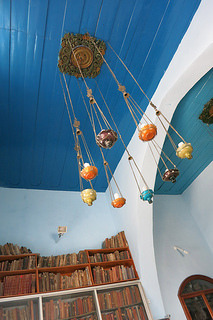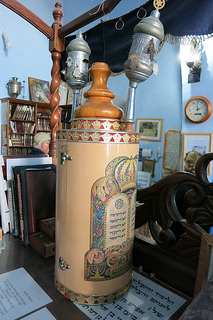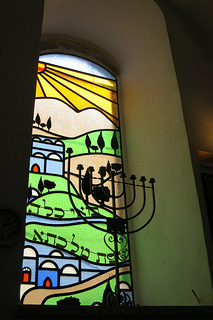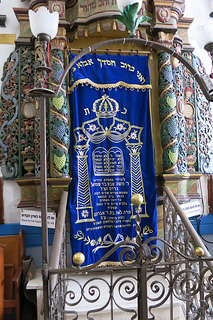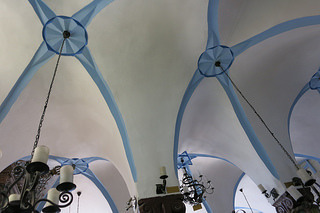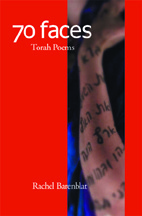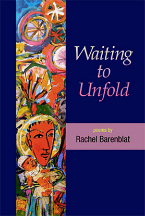Rachel Barenblat's Blog, page 164
March 24, 2014
Two historic synagogues in Tzfat
After a wonderful morning of davening the morning service with my family and celebrating my nephew as he became bar mitzvah, and a delicious lunch at the Bar-El guesthouse, our guide Kobi took us to visit two historic synagogues before setting us loose to wander the streets of the artists' quarter.
At the Karo synagogue: lights, and corner genizah; Sefardic-style Torah case.
The first is the synagogue named after Rabbi Joseph Karo, the author of the Shulchan Aruch, "The Set Table," a compendium of halakha first printed in 1565 which is considered authoritative in many quarters even today. Rabbi Karo was born in Spain in 1488, though emigrated as a child to Portugal when the Inquisition began. After the Jews were driven out of Portugal, he made his way to in Tzfat, where he was chief rabbi for 35 years.
The synagogue we visited bears his name, though it is not precisely the one where he davened. That one was destroyed in the earthquake of 1759. It was rebuilt, and then a second earthquake in 1837 took the second version down, too! But both times, the wall containing the aron, the ark where the Torah scrolls are kept, remained intact. Some saw that as a miracle. Others, our guide noted, attributed it to the fact that the wall containing the ark was double-thick.
At the Ari Ashkenazi synagogue: stained glass window; aron / ark, with wooden carvings.
From there it is a very short walk, only a few scant blocks, to the Ari synagogue, named after Rabbi Isaac Luria who is known as the Ari. That synagogue was built in the late 16th century, and may be the oldest synagogue in Israel to have been continuously in use. The Ari is the one of the original guiding lights of what we know today as kabbalah.
It was the Ari who took his disciples each Friday evening into a nearby field to greet the Sabbath bride -- the custom which has evolved into the service we know today as kabbalat Shabbat, "receiving" or "welcoming Shabat." (If you see a similarity between kabbalat and kabbalah, that's because kabbalah literally means "that which is received" -- wisdom which comes to us from beyond.)
Ceiling at the synagogue of the Ari.
When I think of the Ari, I think of kabbalah. The idea that when God's initial light streamed into creation it was too powerful to be contained, and the vessels of creation shattered, leaving sparks of divinity scattered everywhere, and it's our job to perform mitzvot mindfully and thereby uplift those sparks back to God...? That's Lurianic; that's what tikkun olam means.
When I think of Rabbi Joseph Karo, I think of halakha, because the Shulchan Aruch has been so foundational. It's easy for me to forget that he too was a mystic. It is said that he was visited by an angelic being who taught him secret mysteries of Torah.
I can't say that I had a mystical experience in either synagogue; perhaps the general tourist experience isn't conducive to that. Still, they are truly beautiful prayer places, and I am glad to have visited them again.
Leading my family in morning prayer, again
Seven years ago I had the honor of leading my family in prayer as we celebrated my niece's bat mitzvah. It was my first time leading services for my family, which was an incredibly meaningful experience for me. I had also never led a service by myself for such a large crowd; we were close to 150 people that Shabbat afternoon!
This morning I am once again presiding over a family simcha (joyous occasion) -- the bar mitzvah of that niece's little brother. This time around, a group of about 20 will be davening together in a more intimate setting -- the prayer space at the Bar El bed and breakfast in Tzfat. (This is where the Renewal-style minyan of Tzfat meets during the Days of Awe.)
We're borrowing a Torah scroll from my friend Reuven Goldfarb, who took my "Writing the psalms of our hearts" class at the ALEPH Kallah last summer. (I'm also borrowing a guitar through Reuven, which I deeply appreciate!) There will be song, prayer, poetry, and Torah aplenty.
It's always a joy to be a part of a young person's coming-of-age into a new stage of maturing Jewish identity, and the joy is increased when that young person is part of my own family.
For those who are interested, here's the siddur we created for the occasion: MaxSiddurFinal [pdf]. (The ones we'll be using this morning in Tzfat each have unique covers, featuring art courtesy of my niece; this is just the interior material.) It's a pretty simple weekday morning siddur, with some good poetry interwoven with the prayers -- I'm looking forward to using it.
Whether or not you are davening shacharit this morning, I hope you will think kindly of my family today as we celebrate this lifecycle milestone wtih joy!
March 23, 2014
In Akko: Crusader-era ruins and the Jezzar Pasha mosque
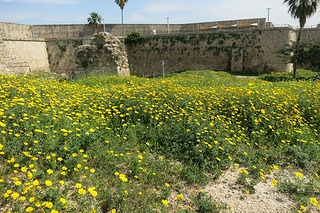 Another new-to-me destination on my family's travels was Akko -- one of the oldest continuously-inhabited sites in the region. (Bet She'an has evidence of habitation for about 6000 years; Akko, about 4000 years.) From the city's Wikipedia page I learned that the first settlement on this site was in the early Bronze age, about 3000 BCE. I also learned that "The name 'Akka is recorded in Egyptian sources from about 2000 BCE, with three signs (the initial guttural, "k" and "a"; followed by the sign for 'foreign city.')" How cool is that?
Another new-to-me destination on my family's travels was Akko -- one of the oldest continuously-inhabited sites in the region. (Bet She'an has evidence of habitation for about 6000 years; Akko, about 4000 years.) From the city's Wikipedia page I learned that the first settlement on this site was in the early Bronze age, about 3000 BCE. I also learned that "The name 'Akka is recorded in Egyptian sources from about 2000 BCE, with three signs (the initial guttural, "k" and "a"; followed by the sign for 'foreign city.')" How cool is that?
At one time Akko was ruled by Rome; then became part of the Byzantine empire; then spent a while under Muslim rule; then the Crusaders took control. By the 1130s it had a population of around 25,000 and was the biggest city in the Crusader kingdom except for Jerusalem. Eventually the Ottomans ruled there; then it became part of British Mandate Palestine. In 1929 there was a pogrom during which Arab residents demolished the synagogue in the old city. Tensions between Arabs and Jews were high again between 1936 and 1939. In 1948, when the city became part of the modern state of Israel, about 3/4 of its Arab inhabitants were displaced. But today it remains a "mixed city," with both an Arab and a Jewish population.
What reading I was able to do before the trip suggested that the relationships between the Arab and Jewish populations here are still complicated: see Arab rock attack at home in Acre, 2013, or The Israeli TV guide to cheap Arab lives, 2014. (Note that those reports come from very different news sources, so they paint quite different pictures.) I'm heartened to read about places like the Sir Charles Clore Jewish-Arab Community Center -- though I don't know enough to know how to balance the existence of a place like that against the other stories to which I just linked.
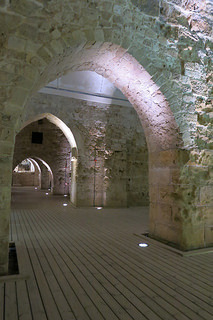 Anyway: given the link that my sister sent out before the trip (Underground Crusader city revealed beneath streets of Acre, Ha'aretz) I suspected Akko was on our agenda for primarily archaeological reasons, and I was right. Here's a glimpse of that Ha'aretz piece to whet your appetite, as it did mine:
Anyway: given the link that my sister sent out before the trip (Underground Crusader city revealed beneath streets of Acre, Ha'aretz) I suspected Akko was on our agenda for primarily archaeological reasons, and I was right. Here's a glimpse of that Ha'aretz piece to whet your appetite, as it did mine:
Preparing to open a new subterranean section to the public, workers cleaned stones this week in an arched passageway underground. Etched in plaster on one wall was a coat of arms — graffiti left by a medieval traveler. Nearby was a main street of cobblestones and a row of shops that once sold clay figurines and ampules for holy water, popular souvenirs for pilgrims.
All were last used by residents in 1291, the year a Muslim army from Egypt defeated Acre's Christian garrison and leveled its remains. The existing city, built by the Ottoman Turks around 1750, effectively preserved this earlier town, which had been hidden for centuries under the rubble.
"It's like Pompeii of Roman times — it's a complete city," said Eliezer Stern, the Israeli archaeologist in charge of Acre. He called the town "one of the most exciting sites in the world of archaeology."
I know that archaeology is often political -- especially in the "Holy Land;" here's a great article about that, actually: Digging for the Truth -- but I couldn't help being excited at the prospect of seeing ruins like these, especially given that the whole Old City is a UNESCO World Heritage Site.
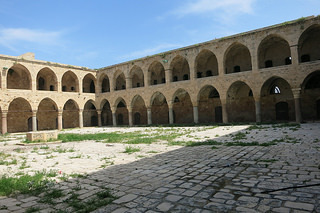 We began with the Ottoman-era Citadel, and then entered the Hospitallers' Fortress, the vast vaulted halls built and used by the Hospitallers knights during the Crusader era, which had been buried for centuries beneath the Citadel and nearby prison. Our guide explained that the structures above them had caved in during an invasion (perhaps the Mamluk invasion? it's hard to keep track!) and it was apparently easier to just fill the spaces with sand and build on top than to clear them out. So for a time, prisoners in the local prison yard did their exercises on top of these ancient hidden halls.
We began with the Ottoman-era Citadel, and then entered the Hospitallers' Fortress, the vast vaulted halls built and used by the Hospitallers knights during the Crusader era, which had been buried for centuries beneath the Citadel and nearby prison. Our guide explained that the structures above them had caved in during an invasion (perhaps the Mamluk invasion? it's hard to keep track!) and it was apparently easier to just fill the spaces with sand and build on top than to clear them out. So for a time, prisoners in the local prison yard did their exercises on top of these ancient hidden halls.
I've never been much of a Crusader buff. Jews didn't fare well during the Crusades, and that's never been a period of history into which I've wanted to delve too deeply. But leaving aside for the moment the problematics of the Crusades as violent holy wars, this complex of early medieval halls and great rooms is dazzling.
Toward the end of our time in the Crusader complex we walked through a tiny underground tunnel which once served as the sewer conduit between this underground complex and the sea -- and then through the Templars' tunnel, which is believed to have been a secret Crusader escape route which allowed them to flee to their waiting boats on the sea. Running water flowed beneath our feet as we trod on a well-constructed wooden walkway, sometimes crouching beneath a surprisingly low vaulted ceiling, and made our way underground to the shore.
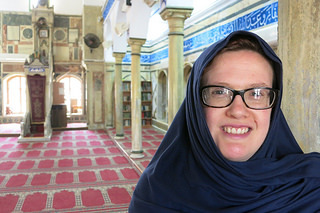 We also visited the largest mosque in Israel outside of Jerusalem, the Jezzar Pasha Mosque , built in 1781. I hadn't known we were coming to a mosque today, so was wearing short sleeves. The friendly gentleman at the entrance to the compound passed out dark blue cloths which several of us used to cover in various ways in order to be appropriately-respectful. Once we were adequately draped, we stepped inside.
We also visited the largest mosque in Israel outside of Jerusalem, the Jezzar Pasha Mosque , built in 1781. I hadn't known we were coming to a mosque today, so was wearing short sleeves. The friendly gentleman at the entrance to the compound passed out dark blue cloths which several of us used to cover in various ways in order to be appropriately-respectful. Once we were adequately draped, we stepped inside.
I'm not sure I would have been much of a fan of Jezzar Pasha himself, whose nickname was "The Butcher." (Sounds like he wasn't very nice to his Jewish chief advisor, Haim Farhi.) But the mosque which takes his name, constructed on his orders in a single year, is quite beautiful.
The Jezzar Pasha mosque inhabits a lush, peaceful courtyard where birds sing and a water fountain (with faucets for wudu) flows merrily. The inlay on the outside of the building is gorgeous, as is the green dome. Inside, names of God twine around the building in gold letters on blue, and beautiful inlay and painted ornament rest side-by-side with an LED clock which displays the time until the next prayers.
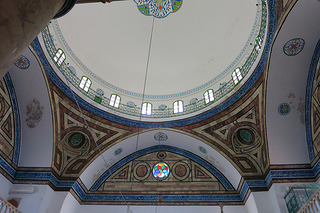 We spent a while walking around its courtyard, admiring the artistry of the Byzantine and Persian ornamentation, and standing in small groups quietly inside the doors of the mosque (not on the prayer rugs, but on a little wooden area just inside the door which was clearly meant for visitors) just letting the space wash over us.
We spent a while walking around its courtyard, admiring the artistry of the Byzantine and Persian ornamentation, and standing in small groups quietly inside the doors of the mosque (not on the prayer rugs, but on a little wooden area just inside the door which was clearly meant for visitors) just letting the space wash over us.
After visiting the mosque, we walked back to the Crusader ruins -- and heard the adhān about two minutes later, while standing in a small grassy square just outside one of the main entrances to the ruins. We stopped and listened to its haunting melodies. God is great! rolled out like auditory calligraphy, floating on the sea-scented air.
All photos in this post come from this trip's photoset, which I'm doing my best to add to each day (wifi permitting.)
March 22, 2014
Walking in (ancient) Caesaria
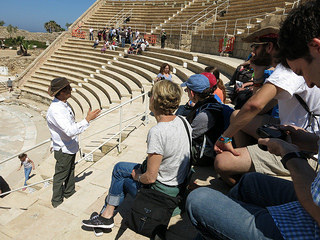 On Shabbat morning I woke up in Jerusalem and, with nearly twenty members of my extended family, boarded a bus heading north. The first place we visited together was Caesaria (קֵיסָרְיָה / قيسارية).
On Shabbat morning I woke up in Jerusalem and, with nearly twenty members of my extended family, boarded a bus heading north. The first place we visited together was Caesaria (קֵיסָרְיָה / قيسارية).
Before our visit, the name mostly evoked the Hannah Szenes poem הליכה לקיסריה, "Walking to Caesaria." Here it is sung by Regina Spektor [YouTube link] -- gives me chills every time. (We often sing this in my synagogue at Yizkor / Memorial services.) The words mean, "My God, my God, I pray that these things never end: the sand and the sea, the rush of the waters, the crash of the heavens, the prayer of the heart."
Wanting to know more than just that beautiful melody, I read the town's Wikipedia page, and here's a snippet of what it says:
The town was built by Herod the Great about 25–13 BCE as the port city Caesarea Maritima. It served as an administrative center of Judaea Province of the Roman Empire, and later the capital of the Byzantine Palaestina Prima province during the classic period. Following the Muslim conquest in the 7th century, the city had an Arab majority until Crusader renovation, but was again abandoned after the Mamluk conquest. It was populated in 1884 by Bosniak immigrants, who settled in a small fishing village. In 1940, kibbutz Sdot Yam was established next to the village. In February 1948 the village was conquered by a Palmach unit commanded by Yitzhak Rabin and its people expelled. In 1952, a Jewish town of Caesarea was established near the ruins of the old city, which were made into the national park of Caesarea Maritima.
After the Roman material -- I'm always fascinated by Roman-era history, ever since spending all of those years studying Latin -- the British Mandate section is most interesting to me, especially the part about the village notable who approached local Jews in an effort to establish a non-belligerency agreement in 1947, and the Haganah presence which followed in 1948, resulting in the expulsion of the town's residents and subsequent demolishing of most of its houses. That said -- we didn't see any of modern Caesaria, so most of that research turned out to be background for a place we didn't visit!
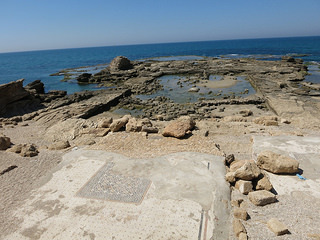 Where we actually went was Caesarea Maritima, the Israeli national park containing the extensive ruins of ancient Caesaria, which was established by Herod the Great around 25 B.C.E. (The town, not the national park, obviously.) Of course, this means that Caesaria isn't mentioned in the Hebrew scriptures, because it's far too recent for that. We spent a neat morning exploring the ruins along with the guide my sister had hired. He was full of interesting facts about, e.g., where the marble to build the columns had come from, and how the theatre and hippodrome were used, and how the city got its name, and how the manmade harbor was built out of concrete laid underwater during the first century B.C.E. (and why it later eroded away).
Where we actually went was Caesarea Maritima, the Israeli national park containing the extensive ruins of ancient Caesaria, which was established by Herod the Great around 25 B.C.E. (The town, not the national park, obviously.) Of course, this means that Caesaria isn't mentioned in the Hebrew scriptures, because it's far too recent for that. We spent a neat morning exploring the ruins along with the guide my sister had hired. He was full of interesting facts about, e.g., where the marble to build the columns had come from, and how the theatre and hippodrome were used, and how the city got its name, and how the manmade harbor was built out of concrete laid underwater during the first century B.C.E. (and why it later eroded away).
Much of what we saw was original -- for instance, the mosaic floors in various places, which were gorgeous -- though the outdoor semicircular theatre is mostly reconstruction, and so is the replica of the stone which bore the inscription "Pontius Pilate dedicated a building here to Caesar in such-and-such a year" -- the original is in the Israel museum, too precious to leave out to the winds and the weather, as it's the only place outside of the Christian scriptures where Pilate is mentioned. Apparently it was found face-down in the theatre; people had been using it as a stepping-stone for years, and were stunned when it was flipped over and they realized its historical importance. I particularly liked the ruins of the palace, with the mosaic floor, and the remnants of what may once have been a swimming or bathing pool, right on the edge of the sea.
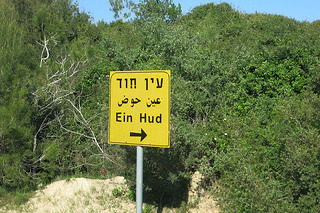 Afterwards we drove along amazingly twisty mountain roads to the Arab village of Ein Hud (not to be confused with the Israeli artists' village Ein Hod, which is next door) for a meal at Habait Be'Ein Hud, which was one of the most extraordinary meals of my life. There is no menu; you just eat whatever the mother of the household has cooked that day. I love putting my trust in a chef's hands like that, and oh, wow, this kitchen did not disappoint. The place was packed, and we were the only English-speaking table in evidence.
Afterwards we drove along amazingly twisty mountain roads to the Arab village of Ein Hud (not to be confused with the Israeli artists' village Ein Hod, which is next door) for a meal at Habait Be'Ein Hud, which was one of the most extraordinary meals of my life. There is no menu; you just eat whatever the mother of the household has cooked that day. I love putting my trust in a chef's hands like that, and oh, wow, this kitchen did not disappoint. The place was packed, and we were the only English-speaking table in evidence.
We were seated at a giant long banquet table next to windows overlooking the hills and wildflowers and olive trees. The food just kept coming: hummus, babaghanoush, tabbouleh, olives and turmeric-pickled cauliflower, every Arabic salad and appetizer I could name (and several I couldn't, including one which I think was made mostly out of Swiss chard with lemon and cumin.) That alone would have been plenty of lunch. But it turned out to be just the prelude to plate after plate of spiced rice and chicken, turmeric-yellow rice surrounded by chunks of fork-tender meat, eggplant in a rich sauce, stuffed peppers...!
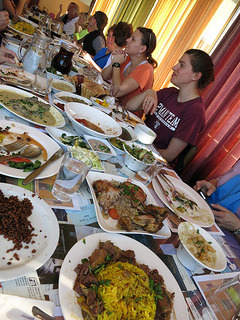 I wish I could have eaten twice as much as I did; it was incredible. I just kept saying "todah rabah! shukran!" to the people who brought the food, over and over again.
I wish I could have eaten twice as much as I did; it was incredible. I just kept saying "todah rabah! shukran!" to the people who brought the food, over and over again.
That meal culminated in a downstairs sitting area, where we were offered tea or coffee (I chose coffee -- in a tiny eggshell teacup, dark and thick and cardamom-scented, which I sweetened with sugar; the flavor immediately took me back to the last time I was in this part of the world!) and ate baklava and relaxed.
There was another surprise in store. I think a local capoeira club happens to practice there on Shabbat afternoons. At least, my sister insisted that she had not hired them as entertainment; they just showed up, turned on music, and fought / danced / did their beautiful graceful moves. We sipped our coffee and tea, and applauded, and one of my older nephews got up and one of the dancers taught him a few of their simpler patterns...and then we got back on the bus and continued on our way.
All photos can be found in my growing photoset from this trip.
March 20, 2014
On my way
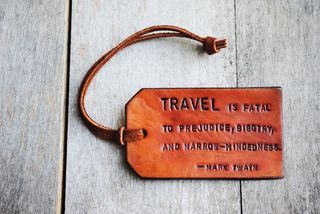 Mark Twain wrote that "Travel is fatal to prejudice, bigotry, and narrow-mindedness[.]" I don't know about fatal, but anyone who travels with open eyes and an open heart can't help but be moved. By the things we have in common across the earth's wide expanse, and by the many fascinating places where we differ in custom, practice, dress, way of being in the world.
Mark Twain wrote that "Travel is fatal to prejudice, bigotry, and narrow-mindedness[.]" I don't know about fatal, but anyone who travels with open eyes and an open heart can't help but be moved. By the things we have in common across the earth's wide expanse, and by the many fascinating places where we differ in custom, practice, dress, way of being in the world.
Travel can shake one out of calcified habits. Days have a different rhythm when one is away from home. Everything seems new, or has the capacity to seem new. Home is about sedentary comfort, the small joys of the mundane and routine. But most of those routines are shattered when one is on the road, waking in an unfamiliar bed, breathing unfamiliar air.
I love my home (the house itself, and the hilltop where it stands, and the community of which it is a part), and I like the rhythms of my life as rabbi, mother, poet, daughter, spouse. And I also love leaving home: walking with renewed attentiveness to the world around me, meeting new people, seeing new things, connecting where I've been with where I'm going.
Traveling, like parenthood, requires yielding a certain amount of control. We make the best plans we can, and inevitably something comes along to shift those plans into a new configuration. Traveling is an exercise in mindfulness and an exercise in cultivating graceful acceptance of whatever gifts the world places in our path, even if they don't look like gifts at the time.
This morning I will drive the familiar winding country roads which take me to the airport an hour away. After a short flight, I'll spend most of the day in an unfamiliar airport. And then I'll get on another plane -- a much bigger one, this time -- and fly all night, arriving tomorrow jet-lagged and disoriented in Tel Aviv.
I've been thinking about this trip for a long time. It was on my mind when I wrote The spiritual work of wrestling with the both/and (February, 2014.) I can't help thinking back to June of 2008 when I last made this journey -- though then I was leaving home for a whole season; this time I'll be abroad for a mere ten days. Then I was a student; now I am a rabbi, and a mom.
I think I know some of what these ten days will hold. (Time with family; a bar mitzvah; a day trip to Hebron; a poetry reading in Jerusalem next Thursday; meals and coffee with friends.) But I'm also going to do my best to be open to surprises, and to find the blessing in every moment, and to keep my mind and heart open to being further broadened, even when that broadening stretches me beyond my usual comfort zone.
I am grateful for the opportunity to make the journey. May all who travel reach their destinations safely, today and every day.
March 19, 2014
A reading in Jerusalem!
I'm thoroughly delighted to be able to announce that I'll be giving a talk and poetry reading in the Baka neighborhood of Jerusalem next week! Here's the event description:
Thursday, March 27, 8pm: Rachel Barenblat on motherhood, poetry, and spiritual life
Join poet and rabbi Rachel Barenblat for a talk about motherhood, poetry, blogging, postpartum depression, and spiritual life. Rachel will intersperse poems from Waiting to Unfold (Phoenicia, 2013) with narrative about new motherhood and postpartum depression, using these poems (written one each week during the first year of her son's life) as a springboard for a conversation about how parenthood shapes both poetry and spiritual life. Depending on the interest of those who are present, she may also talk about Torah poetry and/or about blogging; her blog Velveteen Rabbi was named one of the top 25 sites on the internet in 2008.
I'm really looking forward to sharing poems and conversation. If you are in or near Jerusalem, I hope you will join us! The event will take place at the home of Rachel Shalev, a member of Nava Tehila, the Jewish Renewal community of Jerusalem. Seating is limited, and the event is RSVP only; if you're planning to come, please contact Rachel Shalev and ensure your place.
Deep thanks to author and journalist (and friend) Ilene Prusher, who did the work to set this up for me. Her books will be available for sale at the event, as will a limited number of copies of mine.
Checklist
Passport: check.
Prescription medication: check.
Jeans, skirts, shirts, sweater: check.
Boarding passes: check.
Books loaded on my Kindle.
Charging cables.
Plug converters.
Camera and charger.
Tallit. (Small, blue, silky, portable.)
Siddurim (two in print, plus the two on my tablet.)
Books to deliver to a friend of a friend in the Old City.
Kippot, coordinated with wardrobe.
Carry-on-approved toiletries.
Assorted drug store necessaries.
Rain jacket just in case.
Printouts. Check, check, check.
All I really need is the first stanza.
Everything else is commentary.
I tick things off today's to-do list.
My mind is already en route.
Two perspectives on Zionism
As I prepare for my own departure tomorrow, I've paused in my packing to read two essays written by respected rabbinic colleagues, both published this week in Al-Jazeera. In one essay, Rabbi Ari Hart writes about why he is a Zionist. In the other, Rabbi Brant Rosen writes about why he is not.
Rabbi Ari Hart writes:
The Psalmist says it best: Zionism and the return to Israel is like a dream. It is an ancient dream, thousands of years older than the Holocaust, European anti-semitism and colonialism. It is a three-part dream of returning to the home from which we were exiled, living out our destiny as a people, and bringing righteousness and justice into the world. It is a dream we carried with us from Algeria to Azerbaijan, New York to New Dehli for 2,000 years.
For millennia, the dream lay embedded in Jewish yearning, scripture and prayer, but with only the faintest hope of it being realised. The consistent attempts by Jews to live and flourish in the land of Israel, long before the existence of Zionism as a political ideology, were an expression of that dream. The more recent emergence of political Zionism and the founding of the state of Israel have marked the beginning of that dream coming true.
...The challenge of my Zionism is to recognise two things at the same time: how positive Zionism and the state of Israel have been for the Jewish people and the world, and that a beautiful dream does not always mean a perfect reality.
-- Rabbi Ari Hart, My Zionist dream, my Zionist reality
In response, Rabbi Brant Rosen writes:
Like Rabbi Hart, I am profoundly inspired by the Jewish dream of return so powerfully evoked in Psalm 126. I do not, however, understand these words to be a "blueprint" for Jewish political nationalism. For most of Jewish history, in fact, the Jewish dream of return to the land was not understood literally but was rather projected onto a far-off messianic future. The rabbinic sages who developed Jewish tradition forcefully prohibited the forcing of God's hand through the establishment of an independent Jewish state...
I believe that as Jews, we must be willing to own [our] dark history and say it out loud: during 1947 to 1948, Zionist military forces either displaced or forcibly expelled over 700,000 Palestinians then forbid their return, creating what is today the largest refugee population in the world. Today more than 4,000,000 Palestinians harbour their own dream of return - not to a mythic Biblical homeland but to a land that they remember only too well.
In short, Israel's founding is inextricably bound up with an inherent injustice to the people who had made a home in this land. More critically, it is an injustice that continues until today through policies of dispossession and displacement designed to maintain a Jewish demographic majority in the state of Israel.
-- Rabbi Brant Rosen, A Jewish dream beyond political nationalism.
Reading these two essays side-by-side is an experience of wrestling with the both/and, for sure.
March 18, 2014
A poem from 1999
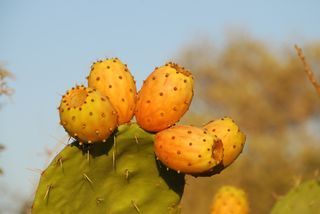 LIMESTONE
LIMESTONE
Texas doesn't have the Mediterranean
but any native knows the similarities.
The sabra is prickly on the outside,
sweet on the inside, like cactus fruit.
Texas has cactus, and we're also
not short on attitude.
Variations: Israeli ranchers are
Bedouins living in corrugated metal
and black plastic, moving goats
and sheep through Judaean desert,
not big men with Rolex watches
and Lucchese boots.
But the sky is the same, and the rocks:
I grew up surrounded by Jerusalem stone.
No wonder Zionism was innate.
Every palm, fig, banana tree
reminded my parents of kibbutz fields
rising like soldiers across the Negev.
This poem appears in my second chapbook What Stays (Bennington Writing Seminars Alumni Chapbook Series, 2002). It's on my mind because I'm about to spend several days with my extended Texas family in that other landscape which looks so much like the one where I grew up -- so similar, and so different, in all kinds of ways.
Sabra is Hebrew slang for "native-born Israeli." The name comes from the plant I grew up calling prickly pear cactus, which grows all over south Texas. (I know the paddles as nopales, an ingredient in Mexican and Tex-Mex cooking.)
There are things I would do differently if I were revising this poem now -- I'm not satisfied with the last line at all; I can see what I was trying to evoke, but I don't think it works -- but this is the way the poem appeared when first published. What Stays had a limited printing, but I still have some copies; email me if you're interested in buying one. (Also someone's selling one on Amazon!)
March 16, 2014
Giving thanks in the present moment: parashat Tzav
 Here's the very short d'var Torah I offered at my shul yesterday for last week's Torah portion, parashat Tzav. (Cross-posted to my From the Rabbi blog.)
Here's the very short d'var Torah I offered at my shul yesterday for last week's Torah portion, parashat Tzav. (Cross-posted to my From the Rabbi blog.)
We read in this week's portion that one who offers a korban for the purpose of thanksgiving must eat that offering on the day when it is offered.
Korban: this is the Hebrew word we translate as "sacrifice." But the root connotes not giving-up but drawing-near.
One who seeks to draw-near to God for the purpose of thanksgiving must eat that offering on the day when it is offered.
Drawing-near to God: we can understand this yearning.
Thanksgiving: we can understand that outpouring.
But what can we make of the exhortation to eat the meat of the sacrifice on the day when it is offered, and not to set any of it aside until morning?
Perhaps this comes to teach us that one who seeks to draw-near to God for the purpose of saying thank You needs to be in the moment. Give thanks for what is, right now, and experience that thanksgiving wholly. Don't hold some of it over until tomorrow: give yourself over to thanksgiving now.
And, a corollary: trust that tomorrow there will again be blessings in your life which merit the giving of thanks.
As I say every Friday morning in meditation: focus on the breath as it comes and goes. And when your mind inevitably drifts to something in the past, or something in the future, that's okay; it's what minds do. Just gently notice that, and on the next exhale let it go and return to right here, right now.
Drawing-near to God in thanksgiving seems to require that same kind of mindfulness, that same cultivated ability to be in the moment and to offer thanks from this moment. There is so much to be thankful for: right here, right now.
Rachel Barenblat's Blog
- Rachel Barenblat's profile
- 6 followers


